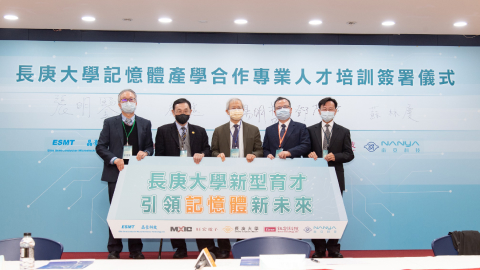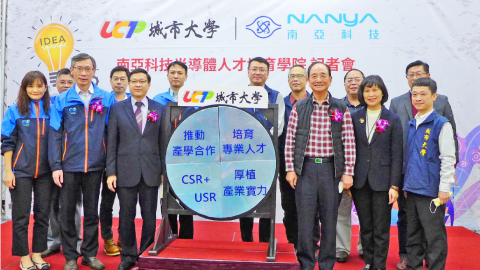
Feature Stories
【Feature Story 1】Towards the Net Zero Emissions Future
Commitment to the SBT and being geared to RE100 with the Goal of Achieving Net Zero Emissions by 2050
Nanya concerned about global climate change and has identified related risks and opportunities. We strive to implement low carbon transition and jointly work towards net zero emissions together with stakeholders. The impact of climate change has been scientifically proven to be extremely urgent. Hence, countries around the world in 2021 declared and took action to achieve net zero emissions by 2050, and Taiwan's government in April 2021 declared the goal of net zero emissions by 2050. As the leader of Taiwan's DRAM industry, Nanya responds to the goal of foreign governments and Taiwan's government to achieve net zero emissions by becoming “A Producer of Green Technology”. We support the Paris Agreement through our own actions and have committed to achieving “Net Zero Emissions”.
Setting SBT(Science Based Target) is a critical first step to achieving net zero emissions, and Nanya proposed its SBT commitment in 2021. Nanya proposed SBT of our current operation locations for review in January 2022, and planned carbon reduction strategies for Scope 1, 2, and 3 emissions, laying out the path to net zero emissions.
Carbon Reduction Strategies
Nanya has planned carbon reduction strategies for Scope 1, 2, and 3 emissions, laying out the path to net zero emissions.
-
Scope 1
Manage raw material use and install end-of-pipe reduction equipment
Nanya's Scope 1 emissions are mainly from the use of process gases for film and etching. Even though the use of process gases cannot be avoided, the Company has adopted "source reduction" and "end-of-pipe removal" to manage GHG emissions.
Source Reduction
The Company is actively improving process efficiency and product yield to maintain competitiveness in the industry. The transition to the 20nm-class process significantly increased production capacity per unit area, and effectively reduces energy and resource consumption per unit production capacity. Nanya has also installed an AI system and uses the assistance of smart factories to analyze data, improve the arrangement of machinery, and manage raw material inputs. Process gases used per unit die has continued to decline in recent years, decreasing 18% in 2020 compared to 2017.
End-of-pipe Removal
Local scrubbers are installed at the end of Nanya's process equipment, and use combustion to break the chemical bond of gas molecules, while using cleaning solution for cleaning to remove the majority of GHGs, such as PFCs, NF3, and N2O. At present, the removal efficiency of equipment used by Nanya is at 90% and above, reducing GHG emissions by approximately 600 thousand tons. Local scrubbers will also be installed in equipment of the new factory to minimize the impact on the environment.
-
Scope 2
Low carbon and renewable energy use
Scope 2 emissions of Nanya are mainly from purchased energy. The Company implements energy conservation management through ISO 50001, and also responds to global trends by using low carbon energy. Nanya first installed solar panels in its own factories, and obtained 362 T-RECs on the T-REC trading platform in 2020. We purchased 10.4 million kWh from onshore land farms in 2021-2022, and signed a 10-year contract with a solar power plant in 2022 to purchase and use 25 million kWh of renewable energy by 2023. We plan to use even more renewable energy to achieve the SBT and RE100, in order for renewable energy to reach at least 25% of electricity use in 2030.
Nanya Renewable Energy Blueprint for the Next Decade
-
Scope 3
Supply chain management and product energy consumption management
Nanya's Scope 3 emissions mainly consists of two items, namely "purchase of raw materials from upstream supply chain" and "electricity consumption from downstream product use." We continue to conduct supply chain sustainability audits for upstream supply chain management, and assist suppliers with environmental management and planning electricity saving projects. The Company jointly implemented ice water pump, cooling water pump, and freezer replacement projects with 14 suppliers in 2021, saving over 3,315 MWh. In the future, Nanya will continue to encourage suppliers to use renewable electricity and implement clean production plans, in order to reduce the carbon footprint of their raw materials.
As for downstream product management, we have focused on the development of advanced processes in recent years. Development of 10nm-class process technology is currently going smoothly, and trial production using second-generation 10nm-class process technology (1Bnm) is expected to begin in 2022, which will improve our production efficiency per unit wafer area by 60% and above. Furthermore, we are also actively developing and carrying out the volume production of low-power products, in which the power consumption of new generation LPDDR5 products is 35% or more lower than LPDDR4 products.
-
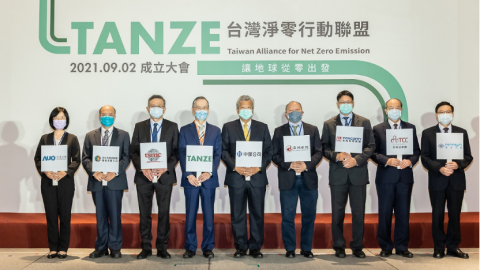 Nanya joined the Taiwan Alliance for Net Zero Emission
Nanya joined the Taiwan Alliance for Net Zero Emission
-
Nanya will become aligned with international trends via the SBT, and will achieve reduction goals for 2030 through product R&D, cleaner production, and upstream and downstream collaboration utilizing our ability to innovate. Furthermore, Nanya will continue to monitor the latest developments of emerging technologies, including semiconductor green process technologies, hydrogen energy, carbon neutral methane, and direct carbon capture technologies. In coordination with the government's carbon trading policy, we hope to offset residual emission by investing in new carbon removal technologies or purchasing carbon rights, gradually achieving the vision of net zero emissions through diverse carbon reduction actions, in order to contribute to the Earth.
【Feature Story 2】Building Taiwan's First 10nm-Class DRAM FAB with Proprietary Technology
Moving towards the smart era, DRAM is a key component to be used in the applications of smart city, smart home, smart office, unmanned vehicles, internet of things (IoT), cloud, artificial intelligence (AI). The global DRAM industry began to recover in 2013 after mergers, and became an oligopolistic market. Nanya ranks fourth in terms of market share. The Company began engaging in transformation and engineering in 2013, including making adjustments to business strategies, actively developing niche memory markets, focusing on consumer electronics and automobile markets, and expanding into server and lower power product markets.
“Innovation is Nanya’s long-term strategic goal and core value. Instead of engaging in joint technology development with other DRAM companies or technology licensing, we began developing proprietary 10 nm process technology in 2017. With accumulating R&D experience and cultivating excellent technology team, we successfully transformed into a self-development process technology IDM company.. The first-generation 10nm-class process technology (1Anm) is expects to begin mass production in 2022. This is the first 10nm DRAM technology in Taiwan, and proves that Taiwan's DRAM technology development ability is among the top companies across the world. The second-generation 10nm-class process (1Bnm) is also under development, and trial production is expected to begin in 2022; 1Bnm process technology will improve energy-efficiency by more than 60%.
Demand on DRAM has benefited from 5G applications and stably increased at a rate of 15-20% each year. Besides planning the investment of NT$60 billion to upgrade processes in current factories, we will invest NT$300 billion to build a 12-inch advanced fab in New Taipei City's Nanlin Technology Park, in order to enhance our future competitiveness and meet long-term development needs. This new factory will be the first 10nm-class DRAM fab in Taiwan with proprietary technology, and will allow Nanya to successfully apply several generations of 10nm-class process technology, which can be used to manufacture next generation products, such as DDR5 and LPDDR5.
-
The new fab will be the largest investment project in New Taipei City, the company held its new Semiconductor Fab groundbreaking ceremony on June 23rd, 2022, the construction is scheduled to be completed by 2025. It is expected to create 3,000 employment opportunities, and also drive the development of memory-related industries, such as smart city, 5G, AI, big data, and IoT, increasing the output value of up-, mid-, and down-stream industries, and indirectly creating several thousands of employment opportunities in the industry chain, which will help drive Taiwan's economic and local development. The advanced fab investment project will secure Nanya's leadership in Taiwan's DRAM industry and position as a key memory supplier worldwide, while enhancing our international competitiveness.
-
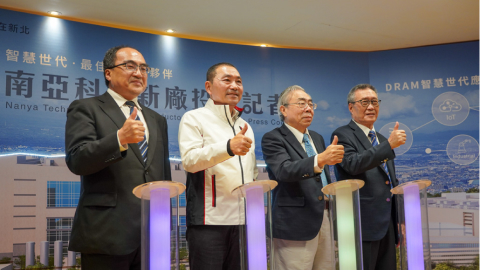 Nanya press conference on investing in a new fab
Nanya press conference on investing in a new fab
【Feature story 3】Cultivating Memory Talent in Taiwan
Memory has become an indispensable to the diverse applications of 5G, AI, electric vehicles, and electronic products. The output value of Taiwan's memory industry is currently nearly NT$300 billion. The memory industry plans to invest over NT$1 trillion to increase its production capacity to meet long-term consumer needs, and therefore urgently needs memory design and process talent.
Nanya has been actively implementing the “Youth Empowerment FOCUS Project” on campuses in response to the shortage of memory talent in Taiwan. With the power of academic research, we assist college students on campus to reduce the gap between the campus and workplace so that they may more quickly adapt to the workplace. At the same time, we integrate the resources of industry and academia to lay the foundation for the Company's talent, and to enhance the international competitiveness of Taiwan's memory industry.
-
Collaborating
with CollegeCollaborating with College Departments to Improve Students' Understanding of the Memory Industry
Nanya organizes a variety of seminars or programs to strengthen the connection between what students learn in school and the actual situation in the workplace. This approach more systematically passing on the experience of industry mentors to students, closely combines theory with applications, and closes the gap between education and employment. We have jointly developed industry courses that meet needs in the workplace, and organize company visits to help students understand the semiconductor industry. Seminars organized by Nanya on campuses to promote knowledge of memory had a total of 4,000 participants, and company visits had over 3,000 participants.
-
Industry-academia Collaboration
Industry-academia Collaboration to Strengthen Students' Knowledge of Memory
Through many campus projects and two-way cultivation, we provide college students with internship platforms that combine academic and industrial resources, and provide training courses and opportunities for accumulating practical experience. We hope that we can become a bridge between enterprises and fresh graduates, and encourage students to develop different abilities, while reserving specialized talent in advance. Nanya has cultivated over 300 semiconductor talents through its internship program Promoted the internship program and offered credit courses in departments, cultivating over 3,000 science and engineering talents.
-
Enhanced Students' Expertise
Enhanced Students' Expertise in the Field of Memory
Nanya encourages outstanding students to focus on academic research and innovative technologies, and established various scholarships or sponsored the scholarships of colleges, in order to cultivate elite semiconductor talent. We hope that outstanding students will continue to learn in fields they are passionate about, and thereby enhance the semiconductor industry's competitiveness. To promote industry-academia exchanges and fully utilize resources of academia, Nanya implemented industry-academia collaboration projects (nearly 30 projects in total) and sponsored events (e.g. NTU VLSI, NTU System-on-Chip (SOC) Center, and NTU IC Summer Camp) of well-known universities.
Furthermore, Nanya and Taipei City University of Science & Technology jointly established the "Nanya Semiconductor Talent Cultivation College in 2022, in order to rapidly pass on experience and cultivate memory talent to meet future market demand. Furthermore, Nanya joined forces with Macronix International Co., Ltd., Elite Semiconductor Microelectronics Technology Inc., and Etron Technology, Inc. and established a master's program for memory in Chang Gung University in 2022. Nanya provides students with professional training in memory IC design and processes through collaborations with schools. This trains students with the core skills needed by the memory industry and cultivates talent for Taiwan's memory industry. The cooperation model between Nanya and schools includes internships, corporate courses, and scholarships, which combine theory with practice. The schools provide complete teaching resources, general education, and theoretical knowledge, while the Company provides a site for internships and large scholarships, and well as guidance in professional knowledge. This allows students to understand the industry and attempt to solve practical problems during their internship. Nanya hopes that cooperation with schools will help cultivate the next generation of memory talent for the country, and also provide students with more learning support and planning options, attracting students to join Nanya and consolidate the country's semiconductor soft power.
【Feature Story 4】Green Technology Production Base
Nanya insists on leaving the best environment to every future generation, and fulfill its responsibility to low carbon production and environmental protection. To become aligned with international eco-friendly trends, Nanya implemented the "Green Factory Label" certification project in 2020, and looked into every detail from the hardware to software process. Thanks to the collective efforts of all employees, factory buildings are required to obtain the Ministry of the Interior's Green Building Label, and production processes are required to pass the clean production evaluation system. We received the "Green Factory" certification from the Industrial Development Bureau, Ministry of Economic Affairs in 2021, and became the first DRAM company in Taiwan to obtain the Green Factory Label. Nanya's new factories in the future will be designed as green buildings, green factories, and smart buildings, in order to drive cleaner production in the domestic DRAM industry and become a manufacturer using green technology.
Green Building Design
Nanya's new head office and new factory established in 2017 were both planned, designed, and constructed according to EEWH. Besides using recyclable and reusable construction materials with low fugitive emissions and low pollution, we referenced ecological, energy conservation, waste reduction, and health indicators of green buildings, and obtained the Green Building Silver Label certificate in 2017. Nanya is currently planning to construct a 12-inch wafer fabrication plant, which is being designed according to green building indicators.
-
Ecology
The architectural design uses native trees or trees that attract birds and butterflies. Besides surface greening, green spaces are also designed on the rooftop and facade, which effective increase carbon fixation. We use JW ecological engineering to design roads that breathe, and effectively increase the site's rainwater harvesting ability.
-
Energy Saving
Electricity consumption by lighting is significantly reduced through the use of lighting from the outdoor courtyard, comprehensive use of LED lights, and reducing the number of lights turned on in non-primary office areas, provided that it does not affect indoor illuminance. Furthermore, we utilize AI to optimize control of the ice water system, and achieve electricity savings through integration, analysis, and AI automated control of machinery, saving approximately 1,830 MWh each year.
-
Waste Reduction
The maintenance of electrical machinery, air conditioning, and telecommunications and Internet pipelines is considered during factory planning, and retains sufficient pipeline space so that the structure and decorations are not damaged during replacement and repair. Air conditioning equipment on the roof all have a base to prevent damaging the waterproof layer during replacement and repair. This reduces the amount of construction materials used, and also reduces the amount of waste generated.
-
Health
We commission an operating environment monitoring institution to measure indoor air quality twice a year, in order to ensure that employees work in a good indoor environment. We monitor the indoor quality and access control in real time through the Central Control to protect employee health and safety. Furthermore, we provide a full-fledged sports and fitness center with an air track, basketball court, badminton court, pool table, table tennis, aerobics room, and massage chair to promote exercise in the Company and improve employees' physical and mental health.
Implementing Clean Production
Nanya continues to make improvements according to clean production evaluation indicators, including energy and resource conservation, green process, and pollutant management technologies, and further incorporates eco-friendly design, green management, and social responsibility concepts to face the environmental impact of our production and operation processes. Nanya obtained the "clean production evaluation system compliance" certificate issued by the Industrial Development Bureau, Ministry of Economic Affairs in 2021 through the evaluation of various qualitative and quantitative indicators.
Green Factory Visits and Exchanges
Nanya achievements in building green factories have attracted visits by the government, schools, and other companies, creating external benefits. Visits by college teachers and students are organized every year, and we have cooperated with the Talent Base Project of the Industrial Development Bureau, Ministry of Economic Affairs and company visits organized in cooperation with 104 Job Bank.
-
Nanya cooperated with the green factory observation and exchange event organized by the Industrial Development Bureau, Ministry of Economic Affairs in October 2021. We explained how we saved electricity, water, and promoted the use of renewable energy, as well as our results. We also shared our experience applying to be certified as a green factory, in hopes of helping participants understand the green measures implemented in our factory. It also helps domestic industries better understand green factories, and can be referenced by other industries and formulating their sustainable development strategies. Furthermore, we utilized our experience to provide guidance to 2 suppliers for green production assessment and evaluation in 2021, expanding the influence of our cleaner production. It also effectively lowers the environmental impact of our overall value chain. In the future, Nanya will continue to provide guidance for suppliers to develop green factories.
-
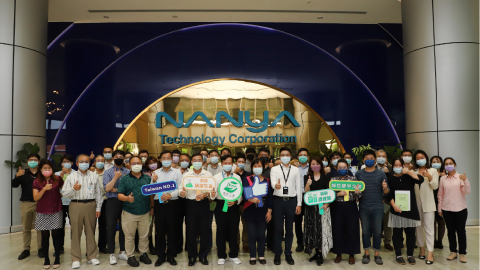 Green Factory Visits
Green Factory Visits
